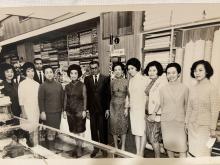Military land around High West
Primary tabs
Last week I walked along Harlech Road, on the north slope of High West. I'd gone to take a photo of the war department boundary stone #18, which lies just a few feet down the slope below the road.
I'd looked carefully along the road before, but only ever found this one stone. On this day though, I happened to be walking the opposite direction from usual - up instead of down. Maybe that's why I spotted stone #11, a little further up the path, but on the slope above the road.
Of course, once you know where to look.... A short walk and there was stone #10, also several feet up the slope from the road.
I wonder how large this war department lot was?
There were plenty of military sites along Harlech Road. At the western end was the Artillery Observation Post. At the eastern end, the road was overlooked by Mount Austin Barracks, and in the central section there was the rifle range.
But I don't think the lot would cover all of them. My guess is that this lot covered High West, possibly including the butts of the firing range.
Another question is the shape of the lot. It's strange that stones #11 and #18 are so close - where did stones #12-17 go?
Finding stones #10 and #11 was a lucky surprise. It was the end of the day, so time to head home, and also time to flee the mosquitoes. I'll go back for a another look when the weather cools down.


Comments
Re: Military Lands
At the turn of the last century, the question of military land tenure in prime locations in the city had always been the subject of friction between the government and the military authorities. The use of prime land by the military restricted major infrastuctural work such as land reclamation, port and road works, building development etc and constrained the development and expansion of the city.
In 1905, the Lewis Agrement was concluded between the government and military authorities for the 'possible' exchange of land between the two parties to take place. The Agreement also spelt out the rights of the military over their land, reserves and encroachments.
To formalise the Agreement, surveys were conducted between 1906 and 1907 on War Department properties at Lyemun, Sai Wan Hill, Devil's Peak, Pinewood, High West and Kowloon East Battery etc. The land between Bowen Road, below the Military Hospital and Kennedy Road was also demarcated. (I suspect the military boundary stones that are evident today originate from this period).
The mechanics of such land exchange was only made clear in 1924 when valuations (supposedly at fair market rates) on prime military properties were set by an arbitrator. Government was allowed to buy back the land from the military but was also required to compensate it with a suitable parcel of land of similar size for defence purposes.
For instance, the military land encompassing Pinewood and High West comprised 3,146, 256 square ft. was grouped as one large parcel and valued at $188,775.00. The valuations for Victoria Barracks were also atrociously high.
It was evident that the government of the day was placed in a no-win situation and so the status quo continued well into the 1980s.
Perhaps a look of the maps of the actual surveys of High West and Pinewood from 1906 and 1907 would give indications of the actual lot sizes. In 1924, Mount Austin Barracks were not part of the Pinewood/High West Allotment.
Re: Military Lands
Moddsey, thanks for the detailed reply. I'd read about the idea of a land exchange when I wrote about the area around admiralty, but I didn't realise the other military areas were included too.
I think I saw one of the survey & mapping office's old maps showed military land marked in red. I can't remember the date though - it will be worth a check when I'm near there next.
Re: Harlech Road
The construction of Harlech Road from Victoria Gap to High West commenced in 1900. The works were undertaken by the military authorities to provide access to sites for batteries at High West and to sites for buildings beyond and to the north of the saddle. Owing to construction delays, the road was finally completed in 1904.
High West batteries
Any idea where they would have been?
There's a flat area at the end of Harlech Road that I've wondered why it was built that way. No signs of any battery there today though.
Access to High West Batteries
As recorded in the public archives for 1900, the intention of building Harlech Road was for this very purpose. It may well however be with the roads completion in 1904 that military considerations may have changed or been overtaken by events. From Ruins of War, I note that Pinewood Battery commenced construction in 1903 and approximately the same period. I also don't recall of any batteries being built on High West.